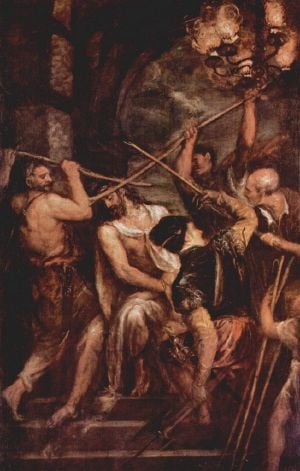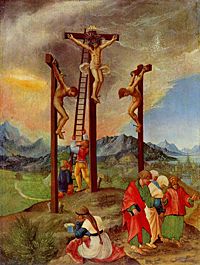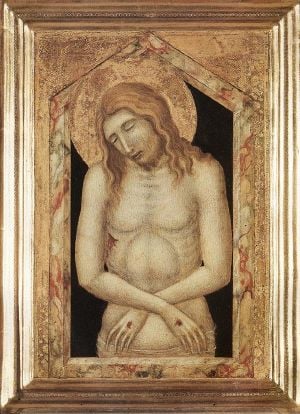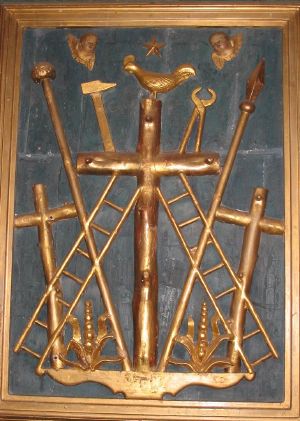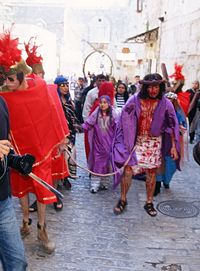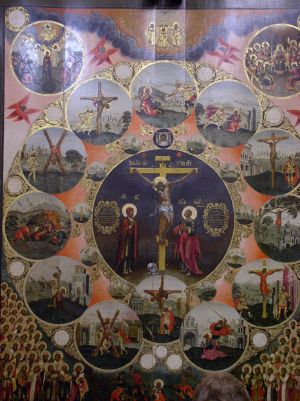Passion (Christianity)
The Passion (from Latin passus "to suffer") refers to the dramatic events surrounding the culmination of Jesus' life including his trial and execution by crucifixion. The Passion of Jesus plays a central role in the theology of most Christian communities, which attempt to explain why Jesus had to endure such great pain, suffering, and humiliation. The events surrounding Jesus' death are described in the New Testament and the parts of the four Gospels that describe these circumstances are known as the "Passion narratives."
The term "the Agony of Jesus" is sometimes used instead of "Passion," although it is more specifically applied to Jesus' action (Greek agon) praying before his arrest in the Garden of Gethsemane.
Many world religions attempt to explain the purpose of suffering in human life. Mainstream Christianity puts Jesus' suffering at the very heart of its theological vision.
Some religious traditions find the glorification of Jesus' suffering an incomprehensible aspect of mainstream Christianity.
Etymology
The origins of the word "Passion" lie in the Latin passus (stemming from pati, patior- "to suffer [to happen]," in the passive sense).[1] It first appears in second century Christian texts precisely to describe the travails and suffering of Jesus in this context. The word passion has since taken on a more general application.
Gospel Accounts
The narratives of the Passion are found in the four canonical gospels, Matthew, Mark, Luke and John. Three of these, Matthew, Mark, and Luke are known as the Synoptic Gospels, give very similar accounts. The Gospel of John includes additional details.
The Passion begins at Matthew 26, Mark 14, Luke 22 and John 12 with the conspiracy against Jesus, which then unfolds in eight scenes:
A meal a few days before Passover. A woman anoints Jesus. He says that for this she will always be remembered.
In Jerusalem, the Last Supper shared by Jesus and his disciples. Jesus gives final instructions, predicts his betrayal, and tells them all to remember him.
On the path to Gethsemane after the meal. Jesus tells them they will all fall away that night; after Peter protests he will not, Jesus says Peter will deny him three times before the cock crows.
Gethsemane, later that night. As the disciples rest, Jesus prays; then a mob led by Judas Iscariot arrests Jesus, and all the others run away.
The high priestâs palace, later that night. The mob brings Jesus to the Sanhedrin (Jewish supreme court); they examine Jesus and determine he deserves to die. They send him to Pontius Pilate.
The courtyard outside the high priestâs palace, the same time. Peter has followed Jesus and joined the mob awaiting Jesusâ fate; they suspect he is a sympathizer, so Peter denies he knows Jesus. Suddenly the cock crows and Peter remembers what Jesus had said.
The governorâs palace, early morning. Pilate, the Roman governor, examines Jesus, decides he is innocent; the Jewish leaders and the crowd demand Jesusâ death; Pilate gives them the choice of saving Barabbas, a criminal, or saving Jesus. In response to the screaming mob Pilate sends Jesus out to be crucified. Judas, the betrayer, is filled with remorse and tries to return the money he was paid for betraying Jesus. When the high priests say that that is his affair, Judas throws the money into the temple, goes off, and hangs himself.
Golgotha, a hill outside Jerusalem, later morning through mid afternoon. Jesus is crucified and dies.
During the arrest in Gethsemane, someone (Peter according to John) takes a sword and cuts off the ear of the high priest's servant, Malchus. According to the synoptic gospels, the high priest who examines Jesus is Caiaphas; in John, Jesus is also interrogated by Annas, Caiaiphas' father-in-law.
The Gospel of Luke states that Pilate sent Jesus to be judged by Herod Antipas because as a Galilean he was under his jurisdiction. Herod was excited at first to see Jesus and hoped Jesus would perform a miracle for him and asked Jesus several questions but Jesus did not answer. Herod then mocked him and sent him back to Pilate after giving him an "elegant" robe to wear.[2]
All the Gospels have a man named Barabbas[3] released by Pilate instead of Jesus. Matthew, Mark and John have Pilate offer a choice between Jesus and Barabbas to the crowd; Luke lists no choice offered by Pilate, but represents the crowd demanding his release.
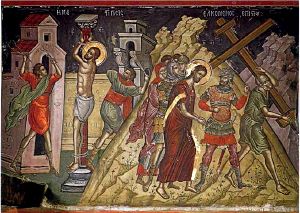
In all the Gospels, Pilate asks Jesus if he is King of the Jews and Jesus replies So you say. Once condemned by Pilate, he was flogged before execution. The Canonical Gospels, except Luke, record that Jesus was then taken by the soldiers to the Praetorium where, according to Matthew and Mark, the whole contingent of soldiers was called together. They placed a purple robe on him, put a crown of thorns on his head, and according to Matthew, put a rod in his hand. They mocked him by hailing him as King of the Jews, paying homage and hitting him on the head with the rod.
According to the Gospel of John, Pilate had Jesus brought out a second time, wearing the purple robe and the crown of thorns, in order to appeal his innocence before the crowd, saying "Ecce homo," "Here is the man." But, John represents, the priests urged the crowd to demand Jesus' death. Pilate resigned himself to the decision, washing his hands (according to Matthew) before the people as a sign that Jesus' blood would not be upon him.
Mark and Matthew record that Jesus was returned his own clothes, prior to being led out for execution. According to the Gospel accounts he was forced, like other victims of crucifixion, to drag his own cross to Golgotha[4], the location of the execution. The three Synoptic Gospels refer to a man called Simon of Cyrene[5] who is made to carry the cross (Mark 15:21, Matthew 27:32, Luke 23:26), while in the Gospel of John (19:17) Jesus is made to carry His own cross. The Gospel of Mark gives the names of Simon's children, Alexander and Rufus. However, the Gospel of Luke refers to Simon carrying the cross after Jesus, in that it states: "they laid hold upon one Simon, a Cyrenian, coming out of the country, and on him they laid the cross, that he might bear it after Jesus."[6] Luke adds that Jesus' female followers were following him, and mourning his fate, but that he responded by quoting Hosea 10:8.
The Synoptic Gospels state that on arrival at Golgotha, Jesus was offered wine laced with myrrh to lessen the pain, but he refused it. Jesus was then crucified, according to Mark, at the third hour (9:00 AM) the morning after the Passover meal, but according to John he was handed over to be crucified at the sixth hour (noon) the day before the Passover meal, though many resolve this by saying that the Synoptics use Jewish time, and that John uses Roman time. Pilate had a plaque fixed to Jesus' cross inscribed, (according to John) in Hebrew, Greek and the Latin - Iesu Nazarenus Rex Iudeorum,[7] meaning Jesus of Nazareth, King of the Jews. Mark has the plaque say simply, King of the Jews. The Gospels then state that they divided Jesus' clothes between the soldiers except for one garment for which they cast lots. The Gospel of John claims that this fulfills a prophecy from Psalms 22:18. Some of the crowd who had been following taunted Jesus, saying "He trusts in God; let God deliver him now!," and suggested that Jesus might perform a miracle to release himself from the cross.
According to the Gospels, two thieves were also crucified, one on each side of him. According to Matthew, both thieves reviled Jesus. According to Luke, one of the thieves reviled Jesus, while the other declared Jesus innocent and begged that he might be remembered when Jesus came to his kingdom.
John records that Mary his mother and two other women stood by the cross as did a disciple, described as 'the one whom Jesus loved'. Jesus committed his mother to this disciple's care. According to the synoptics, the sky became dark at midday and the darkness lasted for three hours, until the ninth hour when Jesus cried out Eloi, Eloi, lama sabachthani? (My God, why have you forsaken me?)[8] The centurion standing guard, who had seen how Jesus died, declared Jesus innocent (Luke) or Son of God (Matthew, Mark).
John also says that, as was the custom, the soldiers came and broke the legs of the thieves, so that they would die faster, but that on coming to Jesus they found he had already died. A soldier pierced his side with a spear.
Other Passion narratives, traditions and scholarship
Veronica
A tradition linked to icons of Jesus holds that Veronica was a pious woman of Jerusalem who gave her kerchief to him to wipe his forehead. When he handed it back to her, the image of His face was miraculously impressed upon it.
The pillar
By tradition, Jesus was tethered to a pillar while flogged.
Rufus and Alexander
The sons of Simon of Cyrene are named as if they might have been early Christian figures known to Mark's intended audience (Brown et al. 628). Paul also lists a Rufus in Romans 16:13.
Old Testament prophecy of the Passion
Christians interpret at least three passages of the Old Testament as prophecies about Jesusâ Passion.
The first and most obvious is the one from Isaiah 52:13â53:12 (either eighth or sixth century B.C.E.). This prophetic oracle describes a sinless man who will atone for the sins of his people. By his voluntary suffering, he will save sinners from the just punishment of God. The death of Jesus is said to fulfill this prophecy.
The second prophecy of Christâs Passion is the ancient text which Jesus himself quoted, while he was dying on the cross. From the cross, Jesus cried with a loud voice, Eli, Eli, lema sabachthani? which means, âMy God, my God, why hast Thou forsaken me?â These words of Jesus were a quotation of the ancient Psalm 22. David as a shepherd sang a mournful lamentation, in Psalm 22, which foretold the sufferings of the messiah:
â⊠I am a worm and no man, the reproach of men and the outcast of the people. All who see me, laugh me to scorn, they draw apart their lips, and wag their heads: âHe trusts in the Lord: let him free him, let him deliver him if he loves him.â Stand not far from me, for I am troubled; be thou near at hand: for I have no helper⊠Yea, dogs are round about me; a company of evildoers encircle me; they have pierced my hands and feet â I can count all my bones â they stare and gloat over me; they divide my garments among them, and for my raiment they cast lotsâ (Psalm 22:7-19).
The words "they have pierced my hands and feet" are disputed, however.
The third main prophecy of the Passion is from the Book of Wisdom. Protestant Christians place it in the Apocrypha, Roman Catholics and Eastern Orthodox among the deuterocanonical books. However, it was written about 150 B.C.E., and many have understood these verses (12-20 of chapter 2) as a direct prophecy of Jesusâ Passion:
âLet us lie in wait for the just, because he is not for our turn⊠He boasteth that he hath the knowledge of God, and calleth himself the son of GodâŠand glorieth that he hath God for his father. Let us see then if his words be true⊠For if he be the true son of God, he will defend him, and will deliver him from the hands of his enemies. Let us examine him by outrages and tortures⊠Let us condemn him to a most shameful death ⊠These things they thought, and were deceived, for their own malice blinded themâ (Wisdom 2:12-20).
In addition to the above, at least three other, less elaborate messianic prophecies have been said to pertain to Jesusâ crucifixion:
âMany are the afflictions of the just man; but the Lord delivers him from all of them. He guards all his bones: not even one of them shall be brokenâ (Psalm 34:20).
"And they gave me gall for my food, and in my thirst they gave me vinegar to drink" (Psalm 69:21).
âAnd they shall look upon me whom they have pierced; and they shall mourn for him as one mourneth for an only son; and they shall grieve over him, as the manner is to grieve for the death of the firstbornâ (Zechariah 12:10).
New Testament prophecy of the Passion
The Gospel explains how these prophecies were all fulfilled in Jesusâ crucifixion:
âSo the soldiers came and broke the legs of the first, and of the other who had been crucified with Jesus; but when they came to Jesus and saw that he was already dead, they did not break his legs. But one of the soldiers pierced his side with a spear, and at once there came out blood and water⊠For these things took place that the scripture might be fulfilled, âNot a bone of him shall be broken.â And again another scripture says, âThey shall look on him whom they have piercedââ (John 19:32-37).
In the Gospel of Mark, Jesus is described as prophesying his own Passion and his Resurrection three times:
- On the way to Caesarea Philippi, predicting that the Son of Man will be killed and rise within three days
- After the transfiguration of Jesus, again predicting that the Son of Man will be killed and rise within three days
- On the way to Jerusalem, predicting that the Son of Man will be delivered to the leading Pharisees and Sadducees, be condemned to death, delivered to the Gentiles, mocked, scourged, killed, and rise within three days
Christians argue that these are cases of genuine and fulfilled prophecy and many scholars see semitic features and old tradition in Mark 9:31.[9] Skeptics argue they are cases of postdiction (prophecy after the events have already occurred).
After the first prophecy, the Gospel of Mark states that Jesus was rebuked by Peter, eliciting the well known response by Jesus of "Get thee behind me, Satan". In particular Peter is criticised for having in mind the things of men not of God, and though many Christians interpret this as an assertion of Jesus' divinity, other scholars, and many early gnostics, argue that it is a rebuke of the Christian school of thought associated with Simon Peter, that which was to become the official Roman Catholic church. Sceptics argue that the events prophesied are inventions.
After the third prophecy, the Gospel of Mark states that the brothers James and John ask Jesus to be his left and right hand men, but Jesus asks if they can drink from the cup he must drink from. They say that they can do this. Jesus confirms this, but say that the places at his right and left hand are reserved for others. Many Christian see this as being a reference to the two criminals at Jesus' crucifixion, thus relating to the Passion. The cup is sometimes interpreted as the symbol of his death, in the light of Jesus' prayer at Gethsemane "Let this cup be taken from me!"
Instruments of the Passion
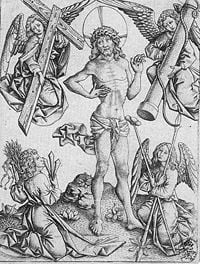
c. 1460 (Kupferstichkabinett, Dresden).
In Christian symbolism and art the Instruments of the Passion or Arma Christi are the objects associated with Jesus' Passion. Each of the Instruments has become an object of veneration among many Christians and have been pictured in paintings and supposedly recovered as relics. Depictions of the Instruments of the Passion may include any combination of the following (though the cross of Jesus is almost always represented):
- The Pillar or column where Jesus was whipped, in the episode of the Flagellation.
- The Flagellum (whip) used for the 39 lashes.
- The Crown of Thorns.
- The reed which was placed in Jesus' hand as a sceptre in mockery.
- The purple Robe of mockery.
- The Cross on which he was crucified (see also the True Cross), either depicted alone or with the crosses of the two thieves.
- The Titulus Crucis, attached to the Cross. It may be inscribed in Latin (INRI, Iesus Nazarenus Rex Iudaeorum), Greek, Hebrew, or some other language.
- The Nails, inflicting four wounds (hands and feet).
- The Holy Sponge set on a reed, with which gall and vinegar were offered to Jesus.
- The Spear by which a Roman soldier inflicted the final of the Five Wounds in his side.
- The Holy Grail, the chalice which was used by Jesus at The Last Supper, and which some traditions say Joseph of Arimathea used to catch his blood at the crucifixion.
- The Seamless robe of Jesus, and the dice which the soldiers cast for it.
- The Rooster which crowed after Peter's third denial of Jesus.
- The vessel used to hold the gall and vinegar.
- The ladder used for the Deposition (removing the body of Jesus from the cross for burial).
- The hammer used to drive the nails into Jesus' hands and feet
- The pincers used to remove the nails.
- The vessel of myrrh, used to anoint the body of Jesus, either by Joseph of Arimathea or by the Myrrhbearers
- The shroud used to wrap the body of Jesus before burial
- The sun and moon, representing the eclipse which occurred during the Passion.
- Thirty pieces of silver (or a money bag), the price of Judas' betrayal.
- The hand which slapped Jesus' face.
- The chains which bound Jesus overnight in prison.
- The lantern or torches used by the arresting soldiers at the time of the betrayal, as well as their swords and staves.
- The sword used by Peter to cut off the ear of the High Priest's servant (sometimes a human ear is also represented).
Sometimes, Veronica's Veil is also counted among the Instruments of the Passion.
Afterward, tradition states that Jesus' body was prepared for burial in a linen wrap that came to be known as the Shroud of Turin[10][11].
Liturgical use
Holy Week
Most Christian denominations will read one or more narratives of the Passion during Holy Week, especially on Good Friday. In the Roman Catholic Church, a large cross depicting the crucified Christ is brought out into the church and each of the faithful come forward to venerate the cross. Rather than having the Gospel read solely by the priest, whole Roman Catholic congregations participate in the reading of the Passion Gospel during the Palm Sunday Mass and the Good Friday service. These readings have the Priest read the part of Christ, a narrator read the narrative, other reader(s) reading the other speaking parts, and either the choir or the congregation reading the parts of crowds (i.e., when the crowd shouts "Crucify Him! Crucify Him!") [12]
In the Eastern Orthodox and Greek-Catholic Churches, the Matins service for Good Friday is called Matins of the Twelve Passion Gospels, and is remarkable for the interspersing of 12 readings from the Gospel Book detailing chronologically the events of the Passionâfrom the Last Supper to the burial in the tombâduring the course of the service. The first of these twelve readings is the longest Gospel reading of the entire liturgical year. In addition, every Wednesday and Friday throughout the year is dedicated in part to the commemoration of the Passion.[13]
Most liturgical churches hold some form of commemoration of the Crucifixion on the afternooon of Good Friday. Sometimes, this will take the form of a vigil from noon to 3:00 PM, the approximate time that Jesus hung on the cross. Sometimes there will be a reenactment of the Descent from the Cross; for instance, at Vespers in the Byzantine (Eastern Orthodox and Greek-Catholic) tradition.
One of the most famous passion plays in the world is performed at Oberammergau, Germany.[14] It has been performed every ten years since 1634, the middle of the Thirty Years' War. The town vowed that if God were to spare them from the effects of the bubonic plague ravaging the region, they would re-enact the passion play every ten years depicting the life and death of Jesus. The villagers believed they were spared after they kept their part of the vow when the play was first performed in 1634. The play, now performed repeatedly over the course of five months, during the last year of each decade, involves over 2,000 performers, musicians, and stage technicians, all of whom are residents of the village. The Oberammergau play has a running time of approximately seven hours. Audiences come from all over the world, often on package tours, the first instituted in 1870. Admission fees were first charged in 1790. Since 1930, the number of attending visitors has ranged from 420,000 to 530,000.
Stations of the Cross
In the Roman Catholic Church (and some Anglo-Catholic and Western Rite Orthodox churches), the Passion story is depicted in the Stations of the Cross (via crucis, also translated more literally as "Way of the Cross"). These 14 stations depict the Passion from the sentencing by Pilate to the sealing of the tomb. The 'Way of the Cross' is a devotion practiced by many people on Fridays throughout the year, most importantly on Good Friday.
Non-musical settings of the Passion story are generally called Passion plays. The Passion figures among the scenes in the English mystery plays in more than one cycle of dramatic vignettes. There have also been a number of films telling the passion story, with a prominent recent example being the 2004 Mel Gibson film[15] The Passion of the Christ.
Musical settings of the Passion
The reading of the Passion during Holy Week dates back to the fourth century. It began to be intoned (rather than just spoken) in the Middle Ages, at least as early at the eighth century. ninth-century manuscripts have "litterae significativae" indicating interpretive chant, and later manuscript begin to specify exact notes to be sung. By the 1200s, different singers were used for different characters in the narrative, a practice which became fairly universal by the fifteenth century, when polyphonic settings of the turba passages began to appear also. (Turba, while literally meaning "crowd," is used in this case to mean any passage in which more than one speaker speaks simultaneously.)
In the later fifteenth century a number of new styles began to emerge:
- Responsorial Passions set all of Christ's words and the turba parts polyphonically
- Through-composed Passions were entirely polyphonic (also called motet Passions). Jacob Obrecht wrote the earliest extant example of this type.
- Summa Passionis settings were a synopsis of all four Gospels, including the Seven Last Words (a text later set by Haydn and Théodore Dubois). These were discouraged for church use but circulated widely nonetheless.
In the sixteenth century, settings like these, and further developments, were created for the Catholic church by Victoria, William Byrd, Jacobus Gallus, Francisco Guerrero, Orlando di Lasso, and Cypriano de Rore.
Martin Luther wrote, "The Passion of Christ should not be acted out in words and pretense, but in real life." Despite this, sung Passion performances were common in Lutheran churches right from the start, in both Latin and German, beginning as early as Laetare Sunday (three weeks before Easter) and continuing through Holy Week. Lutherâs friend and collaborator Johann Walther wrote responsorial Passions which were used as models by Lutheran composers for centuries, and âsumma Passionisâ versions continued to circulate, despite Lutherâs express disapproval. Later sixteenth-century passions included choral âexordiumâ (introduction) and âconclusioâ sections with additional texts. In the seventeenth century came the development of âoratorioâ passions which led to J.S. Bachâs passions, accompanied by instruments, with interpolated texts (then called âmadrigalâ movements) such as sinfonias, other Scripture passages, Latin motets, chorale arias, and more. Such settings were created by Bartholomeus Gesius and Heinrich SchĂŒtz. Thomas Strutz wrote a passion (1664) with arias for Jesus himself, pointing to the standard oratorio tradition of SchĂŒtz, Carissimi, and others, although these composers seem to have thought that putting words in Jesusâ mouth was beyond the pale. The practice of using recitative for the Evangelist (rather than plainsong) was a development of court composers in northern Germany and only crept into church compositions at the end of the seventeenth century. Probably the most famous musical setting of the Passion narrative is Part II of Messiah, an oratorio by George Frideric Handel.
The best known Protestant musical settings of the Passion are by Johann Sebastian Bach, who wrote two Passions which have survived intact to the present day, one based on the Gospel of John (the St John Passion), the other on the Gospel of Matthew (the St Matthew Passion). The Passion continued to be very popular in Protestant Germany in the eighteenth century, with Bach's second son Carl Philipp Emanuel composing over twenty settings. In the nineteenth century, with the exception of John Stainer's "The Crucifixion" (1887), Passion settings were less popular, but in the twentieth century, they have again come into fashion. Two notable settings are the St. Luke Passion (1965) by Polish composer Krzysztof Penderecki and the St. John Passion (1982) by Estonian composer Arvo PĂ€rt. Recent examples include "The Passion According to St. Matthew" (1997), by Mark Alburger, and "The Passion According to the Four Evangelists," by Scott King.
Andrew Lloyd Webber's "Jesus Christ Superstar" (book and lyrics by Tim Rice), and Stephen Schwartz's "Godspell" both contain elements of the traditional passion accounts.
A relative of the musical Passion is the custom of setting the text of Stabat Mater to music.
Notes
- â "Passion." Oxford English Dictionary. (Oxford University Press, USA, 2 edition, 1989. ISBN 978-0198611868)
- â Luke 23:8-12 Retrieved July 11, 2008.
- â Bar-abbas means son of Abbas, the Lord. Some manuscripts of Matthew say Jesus Barabbas, suggesting that an early version of the story contrasted the fate of two men both named Jesus.
- â The meaning of Golgotha is "place of a skull".
- â Cyrene (in Greek, ÎÏ ÏÎźÎœÎ· â Kurene) was an ancient Greek colony in present-day Libya, the oldest and most important of the five Greek cities in the region.
- â Luke 23:26. Retrieved July 11, 2008.
- â The original Greek of the Gospels reads ጞηÏÎżáżŠÏ áœ ÎαζÏÏαáżÎżÏ ᜠBαÏÎčλΔáœșÏ Ïáż¶Îœ áŒžÎżÏ ÎŽÎ±ÎŻÏÎœ, "Jesus the Nazarene, King of the Jews".
- â Mark reports Jesus said Eloi, Eloi, lama sabachthani? in Aramaic; Matthew reports Eli, EliâŠ.
- â Raymond E. Brown. An Introduction to the New Testament. (Doubleday, 1997), 140
- â Picture of Jesus. shroudforum. Retrieved July 23, 2008.
- â The Shroud; the shroud story.Secrets of the Dead. PBS Retrieved July 23, 2008.
- â "Today's Missal: Holy Week" - Pentecost, March 14 - May 17, 2008, Oregon Catholic Press
- â Archpriest D. Sokolof. A Manual of the Orthodox Church's Divine Services, 3rd printing (re-edited) (Jordanville, NY: Holy Trinity Monastery, [1962]2001.), 35.
- â The Oberammergau Passion Play. Retrieved July 20, 2008.
- â The Passion of the Christ. Internet movie data base. Retrieved July 23, 2008.
ReferencesISBN links support NWE through referral fees
- Brown, Raymond E. An Introduction to the New Testament. Doubleday, 1997. ISBN 0385247672
- Kilgallen, John J. A Brief Commentary on the Gospel of Mark. Paulist Press, 1989. ISBN 0809130599
- Miller, Robert J., Editor. The Complete Gospels. Polebridge Press, 1994. ISBN 0060655879
- Sokolof, Archpriest D. A Manual of the Orthodox Church's Divine Services. Jordanville, NY: Holy Trinity Monastery, 1962.
Credits
New World Encyclopedia writers and editors rewrote and completed the Wikipedia article in accordance with New World Encyclopedia standards. This article abides by terms of the Creative Commons CC-by-sa 3.0 License (CC-by-sa), which may be used and disseminated with proper attribution. Credit is due under the terms of this license that can reference both the New World Encyclopedia contributors and the selfless volunteer contributors of the Wikimedia Foundation. To cite this article click here for a list of acceptable citing formats.The history of earlier contributions by wikipedians is accessible to researchers here:
The history of this article since it was imported to New World Encyclopedia:
Note: Some restrictions may apply to use of individual images which are separately licensed.
